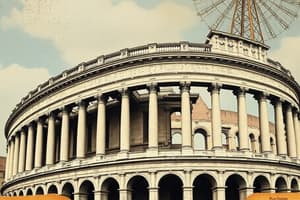Podcast
Questions and Answers
Which two cultures did the Romans borrow from for their architecture?
Which two cultures did the Romans borrow from for their architecture?
- Egyptians
- Greeks (correct)
- Etruscans (correct)
- Persians
Roman architecture was primarily designed for worship outdoors.
Roman architecture was primarily designed for worship outdoors.
False (B)
What was the foundational year of Rome according to legend?
What was the foundational year of Rome according to legend?
753 B.C.
Which of the following periods is NOT associated with Roman architectural development?
Which of the following periods is NOT associated with Roman architectural development?
Name one important Roman emperor who patronized architecture.
Name one important Roman emperor who patronized architecture.
The Romans developed the _______ style, characterized by the use of the arch, vault, and dome.
The Romans developed the _______ style, characterized by the use of the arch, vault, and dome.
Match the following architectural features with their descriptions:
Match the following architectural features with their descriptions:
What was a common Roman building material used in construction?
What was a common Roman building material used in construction?
Study Notes
Origins of Roman Architecture
- Influenced by Etruscans and Greeks due to military conquests.
- Significant Greek influence seen in architectural elements.
- Innovations arose from differing functional needs compared to Greek designs.
- Romans prioritized functionality over idealized forms in architecture.
- Sought interior worship spaces, contrasting with Greek outdoor worship.
Geographical Context
- Italy’s central location in the Mediterranean facilitated cultural spread.
- Rome acted as an intermediary for art and civilization across Europe, Western Asia, and North Africa.
Geological Resources
- Abundant natural resources: marbles, terracotta, stones, bricks, sand, gravel, and timber.
- Concrete created using a mix of stones or bricks, and pozzolana mortar — a building innovation.
Climatic Influence
- Rome's climate is diverse: North Italy has a temperate climate, Central Italy is sunny and pleasant, while South Italy is tropical.
Religious Background
- Polytheistic and ritualistic beliefs influenced architectural styles.
- The Etruscans significantly shaped Roman religious practices and architectural designs.
Architectural Character
- Characterized by vastness, magnificence, ostentation, and ornateness.
- Romans utilized the combination of column, beam, and arch, establishing a distinct architectural style.
Development of Vaults
- Introduction of the Roman Waggon Vault, a semi-circular form adapted for rectangular spaces.
- Use of arches was prevalent in various structures, including the Colosseum and aqueducts.
- Piers in the Colosseum featured half columns supporting the arches.
Notable Structures
- The Pantheon is a prime example, featuring a hemispherical dome and robust buttressing systems to prevent structural failure.
- Architectural structures utilized decorative orders from Greek architecture, but often omitted for functional designs.
Studying That Suits You
Use AI to generate personalized quizzes and flashcards to suit your learning preferences.
Description
Explore the origins and development of Roman architecture from 300 B.C. to A.D. Learn about the significant emperors who influenced and patronized architectural advancements, such as Nero and Hadrian. This quiz will delve into the cultural inspirations from the Etruscans and Greeks that shaped Roman architectural styles.




